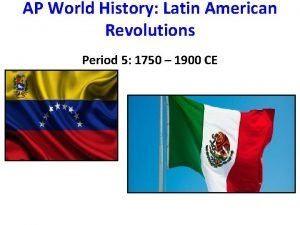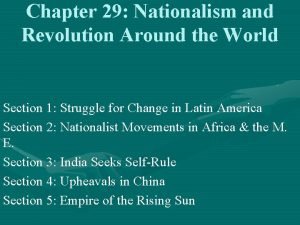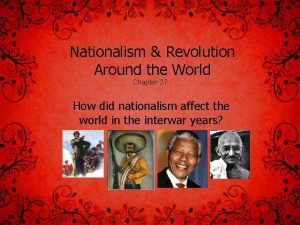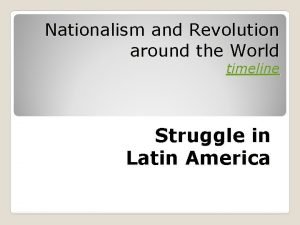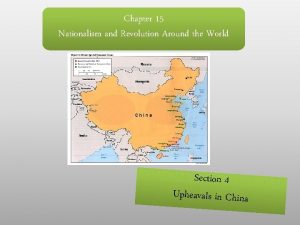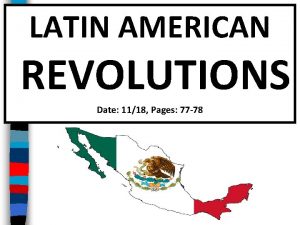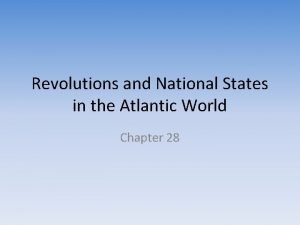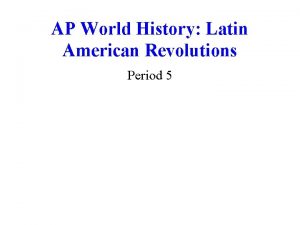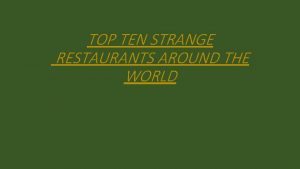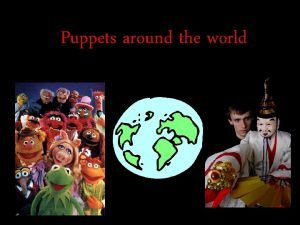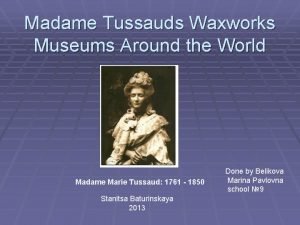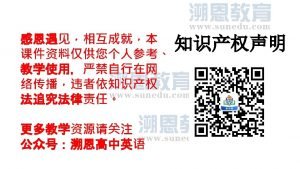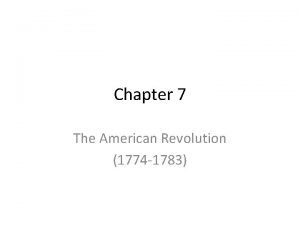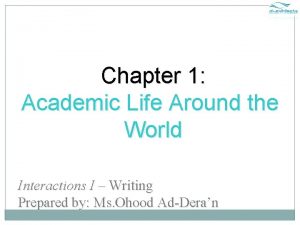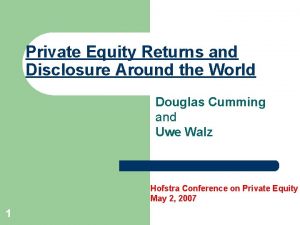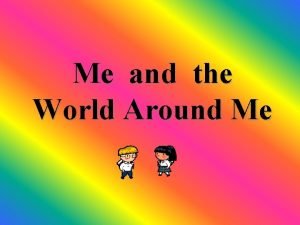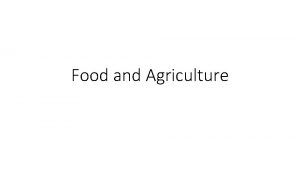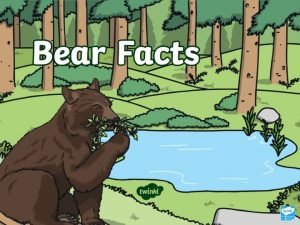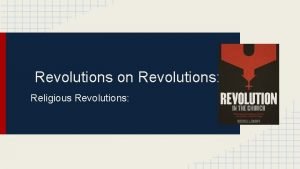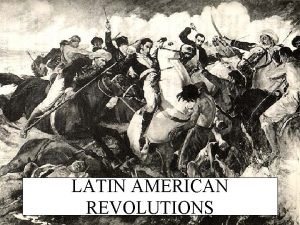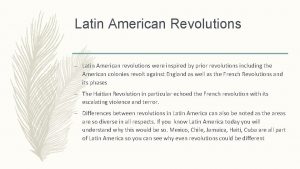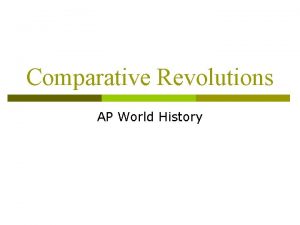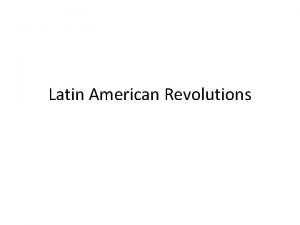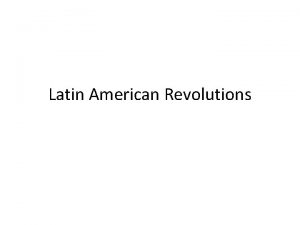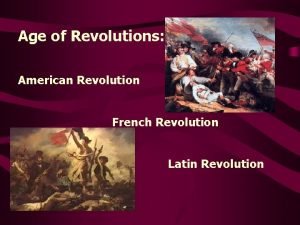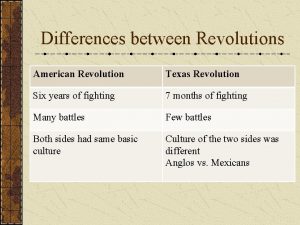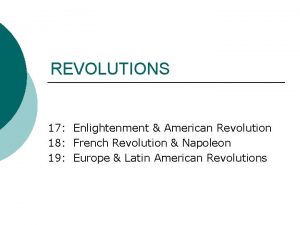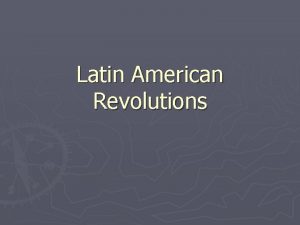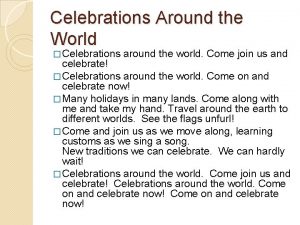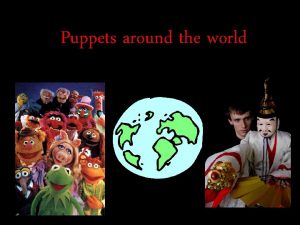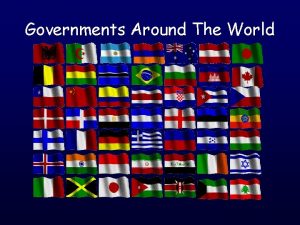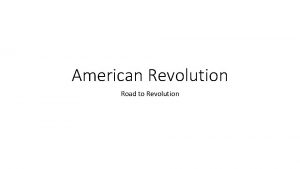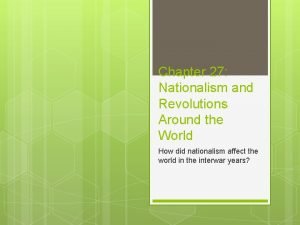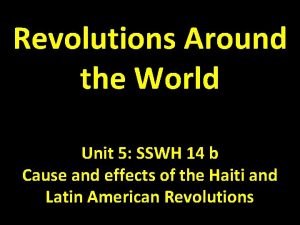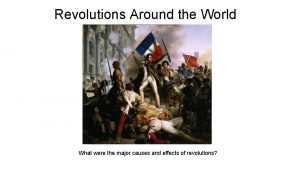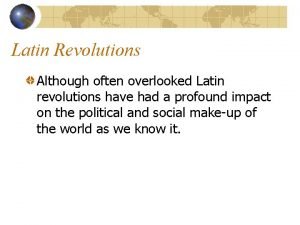Revolutions Around the World American Revolution American Revolution


































- Slides: 34

Revolutions Around the World

American Revolution

American Revolution ¨When- April 19, 1775 - September 3, 1783 ¨Who- The 13 Colonies vs. King George III of Great Britain imposed the Stamp Act (1765) on the colonies in order to continue funding the French and Indian wars. The Colonist claimed that “taxation without representation” was illegal. Colonist begin to boycott the British Taxes, which led to the Boston Tea Party(1773), when shiploads of tea were destroyed. ¨Great Britain places the colonies under control of the British Army.

American Revolution ¨The Rebels (colonist fighting against GB) began to gather weapons in Massachusetts in order to prepare to fight. ¨British troops were sent to destroy the weapons but were confronted by rebels at Lexington Concord April 19, 1775) where the first shots were fired. This became known as “the Shot heard around the world” ¨The Rebels were declared traitors by Britain and the Rebels responded by declaring their independence on July 4 th 1776. ¨In London political support for the war decreased. In April 1782, Parliament voted to end the war in America. The Treaty of Paris formally ended the war in September of 1783

Watch This Video https: //app. discoveryeducation. com/player/view/asset. Guid/bc 8 af 467 -6906 -487 ba 018 -8669 d 7171 c 07

The French Revolution

The French Revolution ´When- 1789 - 1799 ´Who - the common people of France vs. Louis XVI A period of radical social and political upheaval in France. The absolute monarchy that had ruled France for centuries began to collapse. Old ideas about monarchy were overthrown by new Enlightenment principles of equality, citizenship and inalienable rights. ¨The common people of France were increasingly angered by the incompetency of King Louis XVI and on January 21 st, 1793 he was executed. ¨His wife Marie Antoinette was executed later that year in October ¨In September of 1792, France’s first republic was formed. The National Convention. ¨Reign of Terror September 5 th, 1793 - July 28, 1794 Which was the conflict between the Jacobins and the Girondins, two political groups that formed after the monarch fell. During this time 25, 000 people were sent to the guillotine for being accused as “enemies of the revolution” ¨Power exchanged a few more hands before the French Revolution ended in 1799 with a coup d'état led by Napoleon Bonaparte, who became the self proclaimed emperor of France.

Watch Video https: //app. discoveryeducation. com/player/view/asset. Guid/2 b 0 e 1 a 78 -479 f-45 c 5846 f-f 6 f 6 b 05 a 75 d 3

The Haitian Revolution

Haitian Revolution ¨When- August 14 th , 1791 - January 1 st, 1804 ¨Who- The Slave population vs. the French ¨Saint Dominigue ( now called Haiti) was a French colony and the world’s leading sugar producer. ¨A few French families made huge profits from sugar, while most Haitians, nearly 500, 000 were African slaves. Most worked on plantations and outnumbered their masters. Therefore white masters used brutal method to terrorize slaves and keep them powerless. ¨

Haitian Revolution When the French Revolution began, white settlers wanted independence from France. The Slaves had their own goal, which was freedom. ¨In 1791, over 100, 000 slaves revolted. They burned plantation fields and killed hundreds of slave owners. ¨Both sides suffered greatly. ¨Touissant L’Ouverture , a self-educated former slave, organized the slaves in to an effective fighting force. He became general and leader of the Slave revolt. ¨

Haitian Revolution When Napoleon took power in France, he decided to reclaim Saint Dominigue. And in 1802, 16, 000 French troops landed in Saint Dominigue to get rid of Toussaint. ¨L’ Ouverture urged the Haitians to fight to the death against the French soldiers. ¨However, Toussaint agreed to halt the revolution if the French would end slavery. Napoleon Agreed. ¨Despite the agreement, the French reinstated slavery, and sent L’ Ouverture to a prison in France where he died ten months later on April 7, 1803. ¨Now being led by Jean- Jacques Dessalines the Haitians continued to fight the French.

Haitian Revolution ¨After many casualties Napoleon decided to give up his possessions in the New World. He granted Haiti it’s independence making it the first black colony to free itself from European control ¨During this time, Napoleon also sold the French territory in North America to the United States (The Louisiana purchase).

Mexican Revolution

Mexican Revolution ¨When- November 1910 - 1920 ¨The Revolution began on 20 th November 1910 to overthrow the current ruler and dictator Porfirio Díaz Mori. ¨Díaz was an ambitious president, who wanted develop Mexico into an industrial and modernized country. While he worked on implementing a capitalist society building factories, dams, and roads the rural workers and peasants suffered greatly. ¨Díaz used a campaign of bullying and intimidating in order to force citizens to support him. ¨Civil liberties such as the freedom of press suffered under his rule. ¨Diaz made it impossible for anyone who did not have a formal title to own land ¨This left poor farmers in debt and helpless ¨

Mexican Revolution There was no other option but to rise up against him. ¨Francisco Madero led the Mexican people in a revolution that removed Diaz from power. ¨As the new leader of Mexico, Madero promised the people that he would implement a new land reform that would allow them to own land. ¨Unfortunately, he failed to implement the land reform that he promise and was removed from office and executed in 1913. ¨

Mexican Revolution Venustiano Carranza became leader in 1914. ¨ ¨In the pursuit of civil rest he formed the Constitutional Army and a new constitution into which he accepted many of the rebel demands. ¨ ¨The official end of the Mexican Revolution is often taken to be the creation of the Constitution of Mexico in 1917, however the fighting continued for a few more years.

Watch Video

The Cuban Revolution

The Cuban Revolution Fidel Castro Fulgencio Batista

Cuban Revolution ¨When- July 1953 - January 1959 ¨Who- Fidel Castro vs. Dictator Fulgencio Batista ¨ ¨The Cuban Revolution was an armed revolt conducted by Fidel Castro his allies against the regime of Cuban dictator Fulgencio Batista. The revolution began in July 1953, and finally ousted Batista on 1 January 1959, replacing his regime with Castro's revolutionary government. Castro's government later reformed along communist lines, becoming the present Communist Party of Cuba in October 1965. ¨

Cuban Revolution Fulgencio Batista was the elected President of Cuba from 1940 to 1944 and dictator from 1952 to 1959 ¨He then instated the 1940 Constitution of Cuba, deemed progressive for its time, and served until 1944. After finishing his term he lived in the United States, returning to Cuba to run for president in 1952. Facing certain electoral defeat, he led a military coup that preempted the election. ¨Fidel Castro’s July 26 Movement and other nationalist rebelling elements led an urban and ruralbased guerrilla uprising against Batista's regime, which culminated in his eventual defeat by rebels under the command of Che Guevara at the Battle Santa on New Year's Day 1959 ¨Batista fled the country and live the rest of his days in Portugal ¨Castro became the leader of Cuba

The Russian Revolution Vladimir Lenin Joseph (Josef) Stalin

The Russian Revolution ¨When- February 1917 -1918 ¨The revolution removed Tsar Nicholas II from power, and developed into increasingly violent demonstrations and riots on the streets of Petrograd (presentday St. Petersburg) ¨In October of 1917 the Soviet Union was established by Vladimar Lenin. ¨ When Lenin Died, Joseph Stalin took over the communist Party, which continued to rule Russia until 1991.

Iranian Revolution

Iranian Revolution Ayatollah Khomeni Shah Mohammed Reza

Iranian Revolution ¨When January 1978 - February 1979 ¨Who- Shah Mohammad Reza Pahlavi vs. Ayatollah Khomeini (leader of the Revolution) ¨With the help of the US and Britain, Mohammad Reza Pahlavi (the Shah) seized power through a coup in 1953. He worked to modernize the country and expand civil rights, including women’s suffrage. ¨He also became increasingly dictatorial in his approach and used secret police to eliminate political opposition. ¨Ayatollah Khomeini led the clerical opposition to the Shah’s reforms and advocated a strict Islamic state. In 1964, he was arrested and ultimately exiled where he continued to denounce the Shah and the US. ¨In 1978 and 1979, several political groups organized demonstrations against the Shah and his policies which led to martial law. The Shah fled and Khomeini returned. Voters approved a theocratic constitution and established Iran as an Islamic Republic. This was known as the “Islamic Revolution” or “Iranian Revolution. ” Relations with the US significantly deteriorated during this time.

Latin American Revolutions

Latin American Revolutions The Latin American Revolution were an unsettled time for Spanish colonies. It began when Napoleon Bonaparte dethroned Ferdinand replaced him with his brother. This lead to a weakening of Spanish power in Latin America and a surge of support for independent republics. Mexico was the first to revolt and attempt to gain their independence, led by Miguel Hidalgo y Costilla. This revolt, however, was unsuccessful and Hidalgo was executed in 1811. The Revolutions were just beginning, because in 1816 Bolivar returned to Venezuela beginning the tide of successful uprisings. He began to recruit anyone who would fight against the Spanish, and lead an Army against the Spanish government. Meanwhile Jose de San Martin defeated the Spanish in Chile in 1817. This was the first true victory against the Spanish by the Latin Americans. This victory set off a tide of victories for the cause of Latin American Revolutions.

Latin American Revolutions The true fury of the uprising was not felt until Simon Bolivar began to conquer most of northern South America. He and his armies, though outnumbered, won several crucial victories destroying the Spanish Army. Bolivar defeated the Spanish, thus liberating an area he called Grande Colombia. They would later separate into the countries Venezuela, Colombia, and Ecuador. The rest of the Spanish influence is removed with a critical victory by Bolivar's Armies, led by General Sucre. This battle finally liberated Peru, when at the Battle of Ayacucho Sucre defeated the rest of the Spanish Army. Thus Latin America has become a community of free independent nations as opposed to colonies under the thumb of Spanish Rulers.

Watch Video https: //app. discoveryeducation. com/player/view/asset. Guid/1 c 1 a 5 d 26 -3401 -463 dadec-f 1 d 10 fade 345

The Cultural Revolution

The Cultural Revolution https: //app. discoveryeducation. com/player/view/asset. Guid/9 f 0 db 458 -cfb 0 -49 e 9 -9 f 84 -3 c 7 d 400 d 7 bf 0 ¨When 1966 - 1969 ¨Who- Mao Zedong vs. China’s old traditions ¨Social-political movement that took place in the People’s Republic of China from 1966 through 1976. Set into motion by Mao Zedong, then Chairman of the Communist Party of China. ¨Its stated goal was to enforce communism in the country by removing capitalist, traditional and cultural elements from Chinese society, and to impose Maoist orthodoxy within the Party. ¨On August 8, 1966, the party's Central Committee passed its "Decision Concerning the Great Proletarian Cultural Revolution.

The Cultural Revolution ¨The Decision took the existing student movement and elevated it to the level of a nationwide mass campaign, calling on not only students but also "the masses of the workers, peasants, soldiers, revolutionary intellectuals, and revolutionary cadres" to carry out the task of "transforming the superstructure" by writing big-character posters and holding "great debates. " ¨Those who had anything other than a Communist background were challenged and often charged for corruption and sent to prison
 Latin americans in france
Latin americans in france Chapter 29: nationalism around the world answers
Chapter 29: nationalism around the world answers When did mao take over china
When did mao take over china Nationalism and revolution around the world
Nationalism and revolution around the world Nationalism and revolution around the world
Nationalism and revolution around the world Latin american revolutions date
Latin american revolutions date Revolutions and national states in the atlantic world
Revolutions and national states in the atlantic world Economic causes of french revolution
Economic causes of french revolution كما تدين تدان english
كما تدين تدان english Martin luther king of hinduism
Martin luther king of hinduism Jose de san martin ap world history
Jose de san martin ap world history Weird restaurants around the world
Weird restaurants around the world School calendars around the world
School calendars around the world Puppets from around the world
Puppets from around the world Sunday psali
Sunday psali Madame tussauds around the world
Madame tussauds around the world Unit 2 around the world
Unit 2 around the world Light the candles all around the world
Light the candles all around the world Cinderella around the world pdf
Cinderella around the world pdf Why is it called the shot heard around the world
Why is it called the shot heard around the world Academic life around the world
Academic life around the world The world eyfs
The world eyfs Beauty stories from around the world
Beauty stories from around the world Meeting famous people around the world
Meeting famous people around the world Private equity returns and disclosure around the world
Private equity returns and disclosure around the world Hobbies around the world
Hobbies around the world What determines a region's climate
What determines a region's climate Christmas around the world qr quest
Christmas around the world qr quest Tobacco causes _______ of cancer deaths around the world. *
Tobacco causes _______ of cancer deaths around the world. * Foods around the world
Foods around the world First shot around the world
First shot around the world December holidays around the world
December holidays around the world Around the world, the most common residence pattern is
Around the world, the most common residence pattern is Film the mothman prophecies
Film the mothman prophecies Bears around the world
Bears around the world
